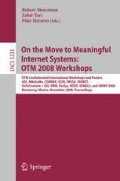Abstract
This paper introduces the notion of Ontology Robustness in Evolution and discusses a solution based on the distinction among a stable component and a contingent component of the ontology. The stable component represents the annotation used to store data into the ontology, while the contingent component contains assertions generated by constraining the assertions in the stable component. This distinction can be used to understand which annotations can be migrated from one old version of the ontology to a new one. This way it is minimized the number of inconsistencies introduced in annotations when evolving an ontology.
Access this chapter
Tax calculation will be finalised at checkout
Purchases are for personal use only
Preview
Unable to display preview. Download preview PDF.
References
Berners-Lee, T., Hendler, J., Lassila, O.: The semantic web. Scientific American 2001(5) (2001), http://www.sciam.com/2001/0501issue/0501berners-lee.html
Gomez-Perez, A., Manzano-Macho, D.: A survey of ontology learning methods and techniques. OntoWeb Deliverable (2003)
Gruber, T.: A translation approach to portable ontology specifications. Knowledge acquisitions 5, 199–220 (1993)
Hahn, U., Marko, K.G.: Ontology and lexicon evolution by text understanding. In: Proceedings of the ECAI Workshop on Machine Learning and Natural Language Processing for Ontology Engineering (2002)
Hevner, A.R., March, S.T., Park, J., Ram, S.: Design science research in information systems. MIS Quarterly 28(1), 75–105 (2004)
Heflin, J., Pan, Z.: A model theoretic semantics for ontology versioning. In: Third International Semantic Web Conference. Springer, Heidelberg (2004)
Huang, Z., Stuckenschmidt, H.: Reasoning with multiversion ontologies: a temporal logic approach. In: Gil, Y., Motta, E., Benjamins, V.R., Musen, M.A. (eds.) ISWC 2005. LNCS, vol. 3729, pp. 398–412. Springer, Heidelberg (2005)
Klein, M.: Change Management for Distributed Ontologies. PhD thesis, Vrije Universiteit Amsterdam (2004)
Kalyanpur, A., Parsia, B., Sirin, E., Cuenca-Grau, B., Hendler, J.: SWOOP: A web ontology editing browser. Journal of Web Semantics (2005)
Malhotra, Y.: Why Knowledge Management Systems Fail? Enablers and Constraints of Knowledge Management in Human Enterprises. In: Holsapple, C.W. (ed.) Handbook on Knowledge Management 1: Knowledge Matters, pp. 577–599 (2002)
Noy, N.F., Klein, M.: Ontology Evolution: Not the Same as Schema Evolution. Knowl. Inf. Syst. 6(4), 428–440 (2004)
Noy, N.F., Musen, M.A.: The PROMPT suite: Interactive tools for ontology merging and mapping. International Journal of Human-Computer Studies 59(6), 983–1024 (2003)
Plessers, P., De Troyer, O.: Ontology change detection using a version log. In: Gil, Y., Motta, E., Benjamins, V.R., Musen, M.A. (eds.) ISWC 2005. LNCS, vol. 3729, pp. 578–592. Springer, Heidelberg (2005)
Stojanovic, L., Maedche, A., Motik, B., Stojanovic, N.: User-Driven Ontology Evolution Management. In: Gómez-Pérez, A., Benjamins, V.R. (eds.) EKAW 2002. LNCS (LNAI), vol. 2473, pp. 285–300. Springer, Heidelberg (2002)
Stojanovic, L., Maedche, A., Stojanovic, N., Studer, R.: Ontology evolution as reconfiguration-design problem solving. In: KCAP 2003, pp. 162–171. ACM, New York (2003)
Vanhoenacker, J., Bryant, A., Dedene, G.: Creating a knowledge management architecture for business process change. In: The Proceedings of the 1999 ACM SIGCPR conference on Computer personnel research, New York, NY, USA, pp. 231–241 (1999)
Ventrone, V.: Semantic heterogeneity as a result of domain evolution. SIGMOD Rec. 20(4), 16–20 (1991)
OWL Web Ontology Language Concrete Abstract Syntax. W3C (2003), http://owl.man.ac.uk/2003/concrete/20031210
OWL - Web Ontology Language defintion, http://www.w3.org/TR/owl-features/
Author information
Authors and Affiliations
Editor information
Editors and Affiliations
Rights and permissions
Copyright information
© 2008 Springer-Verlag Berlin Heidelberg
About this paper
Cite this paper
Ceravolo, P., Damiani, E., Leida, M. (2008). Ontology Robustness in Evolution. In: Meersman, R., Tari, Z., Herrero, P. (eds) On the Move to Meaningful Internet Systems: OTM 2008 Workshops. OTM 2008. Lecture Notes in Computer Science, vol 5333. Springer, Berlin, Heidelberg. https://doi.org/10.1007/978-3-540-88875-8_128
Download citation
DOI: https://doi.org/10.1007/978-3-540-88875-8_128
Publisher Name: Springer, Berlin, Heidelberg
Print ISBN: 978-3-540-88874-1
Online ISBN: 978-3-540-88875-8
eBook Packages: Computer ScienceComputer Science (R0)

